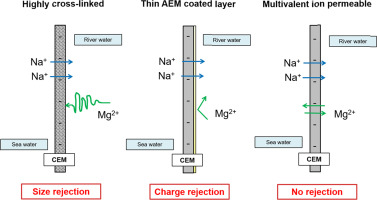当前位置:
X-MOL 学术
›
J. Membr. Sci.
›
论文详情
Our official English website, www.x-mol.net, welcomes your
feedback! (Note: you will need to create a separate account there.)
Mitigation of the effects of multivalent ion transport in reverse electrodialysis
Journal of Membrane Science ( IF 8.4 ) Pub Date : 2018-03-01 , DOI: 10.1016/j.memsci.2017.12.069 J. Moreno , V. Díez , M. Saakes , K. Nijmeijer
Journal of Membrane Science ( IF 8.4 ) Pub Date : 2018-03-01 , DOI: 10.1016/j.memsci.2017.12.069 J. Moreno , V. Díez , M. Saakes , K. Nijmeijer

|
Abstract Reverse electrodialysis (RED) is a sustainable method to harvest energy using the salinity gradient between fresh and seawater. RED technology is developing but efficiencies are still limited when using natural feed water sources. One significant constraint is induced by the presence of multivalent ions in sea and river water (i.e. Mg2+, Ca2+, SO42-). Uphill transport and an increase in membrane resistance in the presence of magnesium ions significantly reduce the power density output obtainable. The choice of cation exchange membrane determines the magnesium transport and as such the power density. Here we investigate four cation exchange membrane types and relate their properties to the stack performance using three different magnesium concentrations on either river and/or seawater side: 1) a highly cross-linked styrene-divinyl benzene monovalent selective cation exchange membrane (Neosepta CMS); 2) a monovalent selective cation exchange membrane that contains a thin polyethyleneimine (PEI) anion exchange layer (Selemion CSO); 3) a multivalent ion (e.g. magnesium) permeable cation exchange membrane with an engineered molecularly open structure facilitating the transport of multivalent ions as recently developed (T1 Fujifilm); 4) a standard cation exchange membrane (Type I Fujifilm (reference)). The first two membranes both retain magnesium ions, while the other two membranes are considered permeable for magnesium ions. The results show that power density strongly depends on the composition of both river and seawater. Power density decreases in the presence of magnesium, an effect being strongest with magnesium at both river and seawater side, followed by the river water side and the seawater side. The negative effect of multivalent ion transport against the concentration gradient, so called uphill transport, in RED can be significantly minimized when monovalent selective membranes such as the highly cross-linked Neosepta CMS membrane or the AEM coated Selemion CSO membrane are used. However, the use of such membranes directly results in a strong increase in membrane resistance due to the lower ion mobility of magnesium ions inside these membranes. As a consequence, power densities in RED are not improved. Especially at high magnesium concentrations, this effect is very strong at higher concentrations, the membranes are no longer able to retain magnesium ions effectively. More beneficial is the application of multivalent permeable membranes with a more ‘open’ structure that allow the free movement of both sodium and magnesium ions through the membrane. Maybe somewhat counter intuitively, such membranes (especially the Fujifilm multivalent permeable T1 membrane) have low resistance values combined with reasonable OCV values leading to high power densities under almost all magnesium concentrations, especially at long term applications. Highest power densities well exceeding 0.3 W/m2 are still obtained when only sodium is present. However, when magnesium ions are present power densities in the order of 0.2–0.25 W/m2 can still be obtained for these membranes.
中文翻译:

减轻反电渗析中多价离子转运的影响
摘要 反向电渗析 (RED) 是一种利用淡水和海水之间的盐度梯度来收集能量的可持续方法。RED 技术正在发展,但在使用天然给水源时效率仍然有限。海和河水中存在多价离子(即 Mg2+、Ca2+、SO42-)会导致一个重要的限制因素。在镁离子存在的情况下,向上传输和膜电阻的增加显着降低了可获得的功率密度输出。阳离子交换膜的选择决定了镁的传输以及功率密度。在这里,我们研究了四种阳离子交换膜类型,并将它们的特性与在河流和/或海水一侧使用三种不同镁浓度的电池组性能相关联:1)高度交联的苯乙烯-二乙烯基苯一价选择性阳离子交换膜(Neosepta CMS);2) 包含薄聚乙烯亚胺 (PEI) 阴离子交换层 (Selemion CSO) 的单价选择性阳离子交换膜;3)多价离子(例如镁)可渗透的阳离子交换膜,具有工程化的分子开放结构,促进多价离子的传输,如最近开发的(T1 Fujifilm);4)标准阳离子交换膜(Type I Fujifilm(参考))。前两个膜都保留镁离子,而其他两个膜被认为可渗透镁离子。结果表明,功率密度很大程度上取决于河流和海水的成分。镁存在时功率密度降低,镁在河水侧和海水侧的作用最强,其次是河水侧和海水侧。当使用单价选择性膜(如高度交联的 Neosepta CMS 膜或 AEM 涂层的 Selemion CSO 膜)时,多价离子传输对浓度梯度的负面影响,即所谓的上坡传输,可以显着减少。然而,由于这些膜内镁离子的离子迁移率较低,使用这种膜直接导致膜电阻的强烈增加。因此,RED 中的功率密度没有得到改善。特别是在高镁浓度下,这种效应在较高浓度下非常强,膜不再能够有效地保留镁离子。更有益的是应用具有更“开放”结构的多价渗透膜,允许钠离子和镁离子通过膜自由运动。也许有点反直觉,这种膜(尤其是 Fujifilm 多价渗透性 T1 膜)具有低电阻值和合理的 OCV 值,导致几乎所有镁浓度下的高功率密度,尤其是在长期应用中。当仅存在钠时,仍可获得远超过 0.3 W/m2 的最高功率密度。然而,当镁离子存在时,这些膜仍可获得 0.2-0.25 W/m2 数量级的功率密度。也许有点反直觉,这种膜(尤其是 Fujifilm 多价渗透性 T1 膜)具有低电阻值和合理的 OCV 值,导致几乎所有镁浓度下的高功率密度,尤其是在长期应用中。当仅存在钠时,仍可获得远超过 0.3 W/m2 的最高功率密度。然而,当镁离子存在时,这些膜仍可获得 0.2-0.25 W/m2 数量级的功率密度。也许有点反直觉,这种膜(尤其是 Fujifilm 多价渗透性 T1 膜)具有低电阻值和合理的 OCV 值,导致几乎所有镁浓度下的高功率密度,尤其是在长期应用中。当仅存在钠时,仍可获得远超过 0.3 W/m2 的最高功率密度。然而,当镁离子存在时,这些膜仍可获得 0.2-0.25 W/m2 数量级的功率密度。当仅存在钠时,仍可获得 3 W/m2。然而,当镁离子存在时,这些膜仍可获得 0.2-0.25 W/m2 数量级的功率密度。当仅存在钠时,仍可获得 3 W/m2。然而,当镁离子存在时,这些膜仍可获得 0.2-0.25 W/m2 数量级的功率密度。
更新日期:2018-03-01
中文翻译:

减轻反电渗析中多价离子转运的影响
摘要 反向电渗析 (RED) 是一种利用淡水和海水之间的盐度梯度来收集能量的可持续方法。RED 技术正在发展,但在使用天然给水源时效率仍然有限。海和河水中存在多价离子(即 Mg2+、Ca2+、SO42-)会导致一个重要的限制因素。在镁离子存在的情况下,向上传输和膜电阻的增加显着降低了可获得的功率密度输出。阳离子交换膜的选择决定了镁的传输以及功率密度。在这里,我们研究了四种阳离子交换膜类型,并将它们的特性与在河流和/或海水一侧使用三种不同镁浓度的电池组性能相关联:1)高度交联的苯乙烯-二乙烯基苯一价选择性阳离子交换膜(Neosepta CMS);2) 包含薄聚乙烯亚胺 (PEI) 阴离子交换层 (Selemion CSO) 的单价选择性阳离子交换膜;3)多价离子(例如镁)可渗透的阳离子交换膜,具有工程化的分子开放结构,促进多价离子的传输,如最近开发的(T1 Fujifilm);4)标准阳离子交换膜(Type I Fujifilm(参考))。前两个膜都保留镁离子,而其他两个膜被认为可渗透镁离子。结果表明,功率密度很大程度上取决于河流和海水的成分。镁存在时功率密度降低,镁在河水侧和海水侧的作用最强,其次是河水侧和海水侧。当使用单价选择性膜(如高度交联的 Neosepta CMS 膜或 AEM 涂层的 Selemion CSO 膜)时,多价离子传输对浓度梯度的负面影响,即所谓的上坡传输,可以显着减少。然而,由于这些膜内镁离子的离子迁移率较低,使用这种膜直接导致膜电阻的强烈增加。因此,RED 中的功率密度没有得到改善。特别是在高镁浓度下,这种效应在较高浓度下非常强,膜不再能够有效地保留镁离子。更有益的是应用具有更“开放”结构的多价渗透膜,允许钠离子和镁离子通过膜自由运动。也许有点反直觉,这种膜(尤其是 Fujifilm 多价渗透性 T1 膜)具有低电阻值和合理的 OCV 值,导致几乎所有镁浓度下的高功率密度,尤其是在长期应用中。当仅存在钠时,仍可获得远超过 0.3 W/m2 的最高功率密度。然而,当镁离子存在时,这些膜仍可获得 0.2-0.25 W/m2 数量级的功率密度。也许有点反直觉,这种膜(尤其是 Fujifilm 多价渗透性 T1 膜)具有低电阻值和合理的 OCV 值,导致几乎所有镁浓度下的高功率密度,尤其是在长期应用中。当仅存在钠时,仍可获得远超过 0.3 W/m2 的最高功率密度。然而,当镁离子存在时,这些膜仍可获得 0.2-0.25 W/m2 数量级的功率密度。也许有点反直觉,这种膜(尤其是 Fujifilm 多价渗透性 T1 膜)具有低电阻值和合理的 OCV 值,导致几乎所有镁浓度下的高功率密度,尤其是在长期应用中。当仅存在钠时,仍可获得远超过 0.3 W/m2 的最高功率密度。然而,当镁离子存在时,这些膜仍可获得 0.2-0.25 W/m2 数量级的功率密度。当仅存在钠时,仍可获得 3 W/m2。然而,当镁离子存在时,这些膜仍可获得 0.2-0.25 W/m2 数量级的功率密度。当仅存在钠时,仍可获得 3 W/m2。然而,当镁离子存在时,这些膜仍可获得 0.2-0.25 W/m2 数量级的功率密度。











































 京公网安备 11010802027423号
京公网安备 11010802027423号